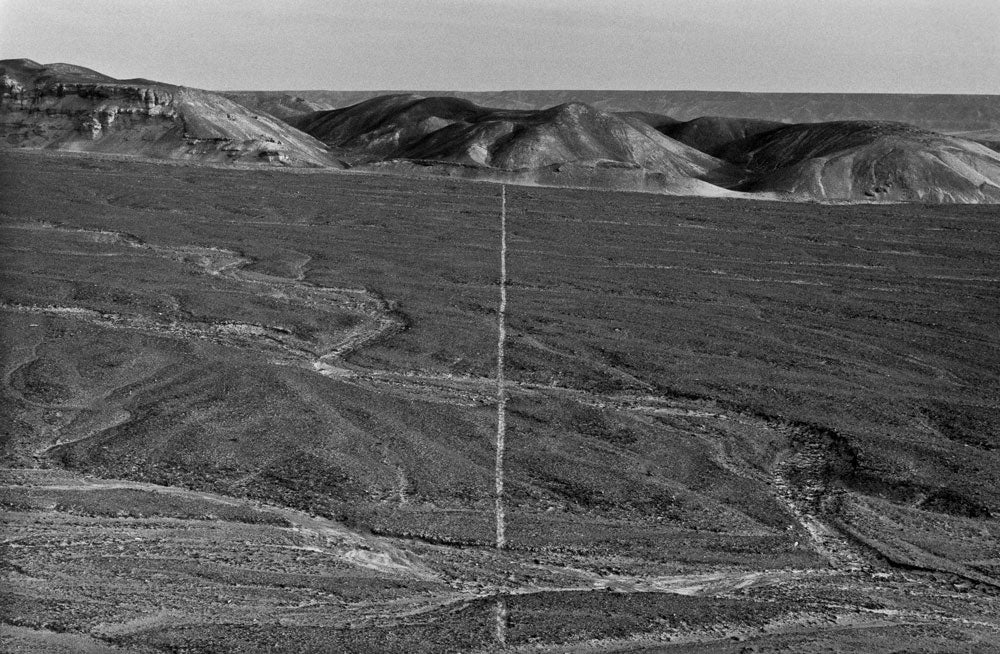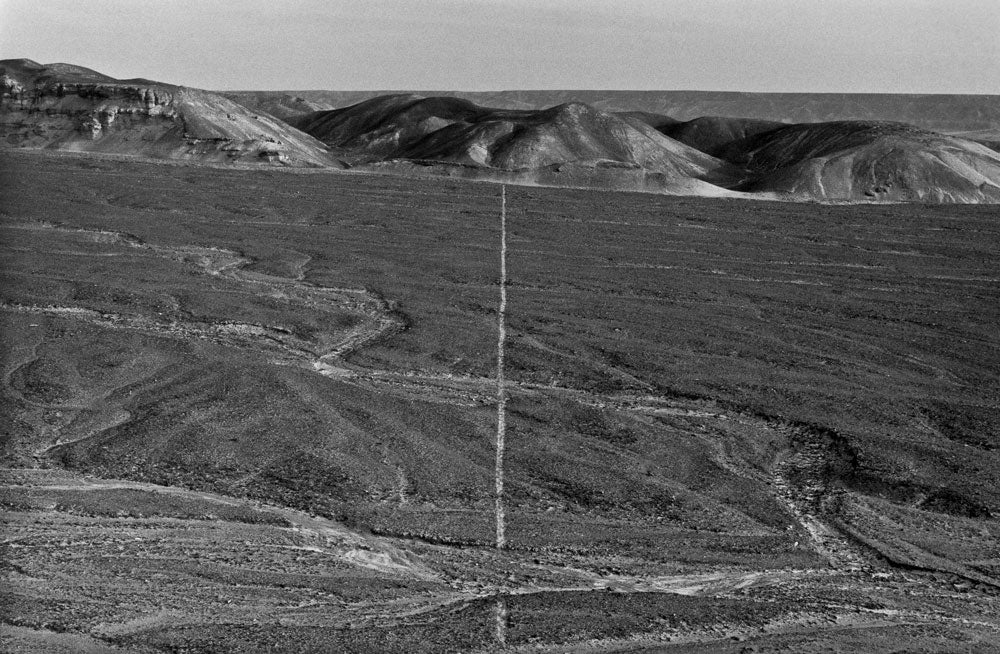Richard Long's work has broadened the idea of sculpture to be a part of performance art and conceptual art. His work typically is made of earth, rock, mud, stone and other nature based materials. In exhibitions his work is typically displayed with the materials or through documentary photographs of his performances and experiences.
Footsteps
Richard Long has been in the vanguard of conceptual and land art in Britain since he created A Line Made by Walking (below) in 1967, while still a student. This photograph of the path left by his feet in the grass, a fixed line of movement, established a precedent that art could be a journey.
Through this medium of walking, time and distance became new subjects for his work. From that time he expanded his walks to wilderness regions all over the world. He mediates his experience of these places, from mountains through to deserts, shorelines, grasslands, rivers and snowscapes, according to archetypal geometric marks and shapes, made by his footsteps alone or gathered from the materials of the place.
These walks and temporary works of passage are recorded with photographs, maps and text works, where measurements of time and distance, place names and phenomena are vocabulary for both original ideas and powerful, condensed narratives.
“All truly great thoughts are conceived by walking,” wrote Nietzsche. Richard Long’s great thought while walking was to make his walking into his art. In an illuminating catalogue essay for Heaven and Earth, Nicholas Serota, director of the Tate, writes, “In A Line Made by Walking (1967), a work made at the age of 22, Long changed our notion of sculpture and gave new meaning to an activity as old as man himself. Nothing in the history of art quite prepared us for the originality of his action.”
Walking a Line in Peru (below) 1972.
“One thing I like about my work is all the different ways it can be in the world,” he says. “A local could walk by and not notice it, or notice it and not know anything about me. Or someone could come upon a circle and know it was a circle of mine. I really like the notion of the visibility or invisibility of the work as well as the permanence and transience. The idea of ephemerality was never my main interest, though. It’s important to say that. Always my interest was to realize a particular idea. Obviously, some of my stone lines just disappear. They get overgrown or moved by sheep, or whatever. That’s great. That’s the natural way of the world. But the reason I made the work has really nothing to do with that. It is simply about making a line of stone in a particular place at a particular time.” -Richard Long

The results of Long’s actions may be brought into the gallery and laid out on the floor, resulting in a sculptural work, or they are photographed in situ, resulting in a picture.
A Line in the Himalayas (above) is one of several photographs resulting from a walk Long undertook in the Nepalese Himalayas in 1975. It shows a rough rocky terrain and snow-covered jagged peaks – a harsh, barren landscape typical to places of high altitude. The sky is a deep, clear blue, tinting the snow and the white rocks. Beginning in the foreground and disappearing into the chaotic texture of dark mountain scree to the side of the image, a narrow raised line of white stones lies almost straight on the landscape. With no human or animal presence of any kind, it is hard to gauge the scale of the stones and rocky outcrops which appear to encompass a great distance: between the foreground and the mountains in the far distance there is no middle ground.

Silence Circle (above) is a variation of a traditional sculpture process due to clearing rather than assembly to create it. This way of making a ‘sculpture’ is only possible in a particular type of terrain, since it requires a loose top layer to be cleared and a uniform layer underneath to be uncovered. The use of the word ‘silence’ in the title brings additional dimensions to the work.
Long typically constructs descriptive titles combining such concrete elements as place, geometric form and materials used, sometimes using a verb describing such actions as ‘walking’ and ‘sleeping’. Here his activity of clearing away the scree-like stones has resulted in a space of emptiness and stillness, or silence as described in the title. Whether this silence is internal to the artist or external to the space and how long the period of silence may have lasted or may have the potential to last, Long has left deliberately ambiguous.
Five Stones (above) made in Iceland in 1974, could also be seen as a drawing of sorts. Here the lines are formed not by Long directly but by the boulders he has rolled down the side of the volcano.
The lines here are less ordered than those he made in A Line Made by Walking. There is a randomness as the stones go with the flow as they journey down the mountainside; it looks in a way as though they were racing.
In a way, perhaps, it’s appropriate that the interventions into the English landscape are ordered – polite, almost to the point of counting as gardening – whereas there is an uncontrolled wildness to the work made in the more rugged terrain of an Icelandic volcano.
"I guess I'm an opportunist, really. I go out into the world with an open mind, and I rely to a degree on intuition and chance. The idea of making art out of nothing, I've got a lot of time for that. Walking up and down a field, or carrying a stone in my pocket, it's almost nothing, isn't it?" - Richard Long
Craig Pearce
Craig is the founder behind GOODLAND, who launched the company with the Wood Burning Hot Tub. A designer and furniture maker, he’s passionate about creating well-designed and minimal objects and tools to connect people with nature — knowing that when we move half as fast, we notice twice as much.








